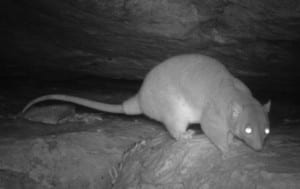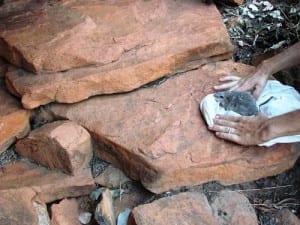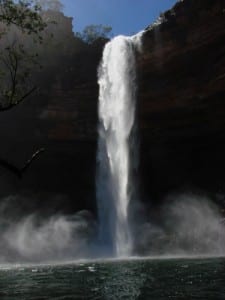On the search for the Scaly-tailed possum: Wet and Wildlife
By Jack Ashby, on 11 December 2014

A scaly-tailed possum caught on a camera trap
in AWC’s Artesian Range.
(C) Australian Wildlife Conservancy,
Over the past few years I have been spending my spare time in a remote area of the Kimberley, on the northwest corner of Australia, helping a conservation NGO – the Australian Wildlife Conservancy (AWC) – to do ecological fieldwork. AWC are Australia’s largest private owner of land for conservation, and their mission is to manage it based on scientific research. In the northwest their big long-term projects involve determining the effects of cattle and different fire management practices on tropical savannah ecosystems. And in my most recent two trips I’ve been lucky enough to be involved in the detection of super-scarce species in extremely remote pockets of rainforest and monsoonal woodland.
A few years ago AWC acquired an amazing patch of the Kimberley called Artesian Range – monsoonal savannah criss-crossed with sandstone ranges, gorges of vine-thickets and rainforest pockets. I remember going through the first set of remote camera trap images that came back from Artestian in 2011 and being amazed at the species that were being detected.
The haven from extinction
It seems that Artesian Range is the only place in mainland Australia not to have suffered any mammal extinctions since European colonisation. A community of amazing endemics has clung on – scaly-tailed possums, golden-backed tree rats, monjons, golden bandicoots and Kimberley rock rats. When I was analyzing those camera trap images in 2011 I was a couple of hundred kilometres south of Artesian, on AWC Northwest’s main home sanctuary, Mornington. Artesian Range is in one of the least accessible parts of Australia, requiring a combination of propeller-plane, serious 4WD and helicopter to get to. As amazing as it was to see these species on the screen, I instantly knew I had to go and see them in the flesh. For me, the scaly-tailed possum had become the holy grail.
How far do they reach?
Soon after, the AWC Northwest ecologists ventured into Artesian Range for live trapping and found a number of clustered locations that these species, the “Artesian specials” were found. Having proved that they weren’t all extinct in this region, the next question was to determine the how far their ranges extended. If Artesian Range was a “sink” for the exciting mammal species, then inventories of the species in the areas that they could feasibly disperse into had to happen, on to other parts of the AWC property as well as neighbouring government Crown Land and cattle stations.
Check out this awesome video about AWC’s work in Artesian.
Getting the call
I got the call to join two trips to the area (in November 2012 and January 2014) to trap sites on possible dispersal routes out of the Artesian hotspot, to see how far their ranges extend. I went to each trip with extremely high hopes, but a sleep-depriving fear that they might be too far from the centre to find the scaly-tailed possum.
November 2012: Trapping the heat
These two times of year are actually quite challenging to work in – November’s season is known as the “Build Up” – the hottest and most humid time of the year, before the monsoon hits. In order to avoid the 40+°C heat and the 80-95% humidity, we would check our mammal traps between about 4am and 8.30am, and then sit in a cave or a pond we could be reasonably confident lacked saltwater crocodiles all day until we could venture out to reset the traps in the evening.
Every four or five days the helicopter would come and drop us in a site that had the characteristic sandstone gorges with boulder fields, rainforest and vine-thicket pockets. We hauled our equipment over creeks and rock features (rarely through creeks as saltwater crocs were EVERYWHERE: standing by camp on one of the sites one night – on a major tidal river – I counted seven between me and the far bank) to see what species we could find. We laid traps and cameras, and spent the nights searching by spotlight.
November 2012 was a good trip – we found golden back tree rats in a couple of spots (in the tree above our tents, it turned out), monjons and Kimberley rock rats. This was amazing, but not the dream scaly tailed possum (or golden bandicoots). I’d have to go back.
January 2014: Wet and wildlife
January 2014 gave me a taste of the Wet Season in full swing. It’s an incredible time of swollen rivers, suddenly appearing waterfalls and six hour long thunder storms where lightning flashes more than once a second. The amazing things that the water did to the gorge-ridden landscape made it impossible to resent the inch of water in my tent.
Once again, the holy grail evaded me – rock rats were everywhere, and we had some exciting encounters with more common species like an echidna, quolls and ningbings, but the scaly-tailed possum stayed out of reach. Frustratingly, a week or so after we left one of the January sites, a possum wandered through one of the camera traps we left set in the forests. Obviously I’m pleased the species is there, but I can’t help feeling that nature is cruel.
Of course, you can’t prove absence, but trips like this have helped determine that the Artesian Range’s special species seem not to venture too far. Now that the inventory of neighbouring properties is drawing to a close I’ll have to get myself onto one of the trips back to the heart of this amazing, extinction-free oasis, and finally set eyes on that scaly-tailed possum.
Jack Ashby is the Manager of the Grant Museum of Zoology.
 Close
Close







